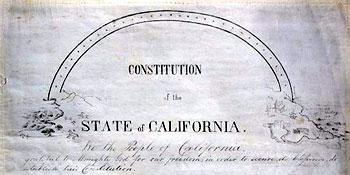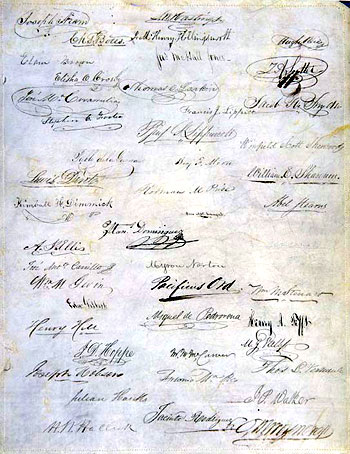|
The cry, "gold!" was shouted from Sutter's Fort in
January of 1848 and the rush to California
was on soon after. Within three years the non-Indian population swelled
from 18,000 to 165,000. Immigrants from the eastern United States,
Mexico,
South America,
Europe,
Asia, Hawaii, Australia, and more, journeyed by land and by sea, enduring great hardships along
the way just "to see
the elephant". Some turned back after seeing the elephant's tracks
or tail, and claimed that just the view was enough for them. Others
struggled with a new way of life and helped to build the
California
that we know today.
Dreams of Statehood
With the on rush of argonauts, it became inevitable that the
golden land that had been seized by Americans during the Bear Flag
Revolt of 1846 would begin dreaming of statehood. The first U.S.
military governors happily left the acaldes in rule, but the new
American Californians soon decided the Mexican system was not sufficient
for them. On
June 3, 1849, military governor, Brigadier General Bennet Riley, called for a state
constitutional convention. Forty-eight delegates were chosen to convene at Colton Hall in Monterey
on September 1, just for that purpose.

Amongst the 48 delegates to this constitutional convention, 37 were Americans, seven were Californios of Mexican descent, and
four were foreigners. All were males, primarily between the ages of
30-50. Dr. Robert Semple, the founder of the city of
Benicia
and of Bear Flag Revolt fame, was elected to preside over the
convention. Other notables were: John Sutter, the owner of the sawmill
where the gold rush began; native Californian and former Northern
California Mexican military commander, General Mariano Guadalupe
Vallejo; rich land speculator and former Mississippi congressman, Dr.
William Gwin; Don Abel Stearns of Southern California, and Henry W.
Halleck, Secretary of State under the military regime and future
commander of Union armies during the Civil War.
Issues of Importance
Some of the issues the delegates discussed during the convention
were: slavery, suffrage, state boundaries, women's properties rights,
dueling, and where the state capital would be. It was unanimously
decided that slavery would be prohibited, and free African Americans
would be allowed in the state. The decision was easily met, primarily
because miners in the gold fields firmly believed that every man should
dig for his own future, and did not want to compete with slaves. So far
as suffrage, only white males would be allowed to vote, although Indians
or their descendants could be granted the right by special legislature
act. Women could not vote, but
they were allowed to hold their own separate property, provided that
they were married, of course. Dueling was voted against, and all persons
charged with criminal offenses, be it dueling or any other, were to be
tried by a jury of their peers. After argument over whether the state
boundary should be the great
Rocky Mountains, or somewhere near Utah's Salt
Lake, the more natural boundaries of the Sierra Nevada
Mountains
and the
Colorado River
were favored. Although the state capitol would be moved a few times in
the future, the pueblo of San Jose
was chosen at this particular time.
"That's for California"
On
October 10, 1849, the California
constitution was adopted. The afternoon of October 13th, it was signed,
and the convention was adjourned soon after.
In his book "El Dorado: Or Adventures in the Path of the Empire", traveling journalist,
Bayard Taylor told of the historic event, which he personally had
witnessed:
The windows and doors were open, and a delightful breeze came in
from the bay, whose blue waters
sparkled in the distance. The view from the balcony was bright and
inspiring. The town below--the sipping in the harbor--the pine-covered
hills behind--were mellowed by the blue October haze, but there was no
cloud in the sky and I could plainly see, on the northern horizon, the
mountains of
Santa Cruz
and the Sierra de
Galivan.
The citizens…as well as the members, were in an excited mood.
Monterey
never before looked so bright, so happy, and so full of pleasant
expectation.
About
one o'clock
…they proceeded to affix their names to the completed Constitution.
At this moment a signal was given; the American colors ran up the
flagstaff in front of the government buildings, and streamed out on the
fort, and its stirring echoes came back from one hill after another,
till they were lost in the distance.
As the signing went on, gun followed gun from the fort, the
echoes reverberating around the bay, till finally, as the loud ring of
the thirty-first was heard, there was a shout:
"That's for California!" and every one joined in giving three times three for the new
star added to our Confederation.
Eight thousand copies of
California's first constitution were printed, 2,000 of which were in Spanish. An election was set for November 13, in hopes of a good turn out
before the rainy season would come. However, in 1849, the rains came
early and only 15 percent of the eligible electorate turned out. The
rains weren't the only deterrent, many were not even aware of an
election in the first place. Regardless, the constitution was ratified
and a man by the name of Peter Burnett was elected as first governor of California
.
Down to Business
December 15, 1849
was chosen as the date for California's first legislature to convene in San Jose. Once again the rains came, and they were heavy, as they are prone to
do at times. All roads to the pueblo were nearly impassible and not
enough people showed up for a quorum to be reached. By December 17th,
enough legislators showed up that business could begin, and the
inauguration of Peter Burnett and other government officials was set for
December 19th. By the time the 19th showed up, the weather was bad once
again, and the inauguration was postponed once again. At last on
December 20, 1849
, Peter Burnett took the oath of office, as did the others.
General Bennet Riley proclaimed the existence of the new State of
California, and handed the government over to civilian administration.
Now that the inauguration was completed, the legislature began
organizing the new state that had been created. The United States of America
had not yet officially acted on California
's petition for statehood, and would not do so for another ten months.
Californians did not waste any time, however, and elected John C.
Fremont and William Gwin as their first United States
senators. They also approved legislation allowing the Secretary of State
to collect historic documents to be set aside for public archives.
English common law was set up as the law of the land, a court system,
and taxation, judicial and
government codes were also established.
The Great Compromise
The United States Congress was in deep conflict over issues of
slavery during this time period in history. The country was divided into
the 15 slave states of the South and 15 free states
of the North. The admission of California
as 31st state created heated debates. Should it be admitted as a free state, a slave state, or perhaps not at all?
The great senators, Henry Clay of Kentucky, and Daniel Webster of
Massachusetts, helped to decide the issue by creating the Compromise of 1850 which
would admit California
as a free state
provided the territories of New Mexico
were organized with no reference to slavery. President Zachary Taylor,
unfortunately, was against compromise, and wanted California
immediately admitted to the
Union
as a
free state. This created even more havoc to the situation. Nine Southern states
threatened to secede if the free state of California
was admitted. Zachary Taylor
died in office in July and was succeeded by Millard Fillmore, who
favored the Compromise and helped move things along.
"California
Is A State"
It was 11 months after the creation of the California
Constitution, but at last on
September 9, 1850
, the golden state of California
was officially accepted as the 31st state of the
United States of America. With over one thousand land miles separating the Eastern states from
the newly formed one on the Western coast, the news was slow to get out.
On
October 18, 1850, the steamer Oregon sailed into the
San Francisco
Bay
proudly bearing a banner from her rigging that proclaimed
"California Is A State." Places like San Francisco
and
Sacramento
celebrated at last. As for those "who saw the elephant" and
pursued their dreams, they barely put down their shovels to notice.

Bibliography
They
Saw The Elephant: Women in the
California
Gold Rush
by
Jo Ann Levy
University
of
California
Press
Archives & California
State
History
Museum
http://www.ss.ca.gov/archives/archives.htm
A
Zigzag Path Led to Statehood
http://www.calgoldrush.com
California
Becomes a State
Constitution
and
California
Statemaking 1849-1850
http://www.learncalifornia.org
Early
California
California
's Constitutional Convention of 1849
http://www.militarymuseum.org
|

